
Union Environment Minister Bhupender Yadav on Sunday said the rise in the Asiatic lion population is an "astounding success" and called it a global symbol of "successful wildlife conservation".
Speaking at an event in Gujarat's Devbhumi Dwarka district on the occasion of World Lion Day, Mr Yadav said India's lion population has grown to 891, up from 674 in 2020.
"The Asiatic Lion (Panthera leo persica) is a global symbol of successful wildlife conservation, and on this World Lion Day, we celebrate their remarkable recovery. From just 284 lions in 1990, the population has now risen to 891 in 2025 - a 32% increase since 2020 and over 70% growth in the past decade," he said.
India draws immense pride from being home to the Asiatic Lion 🦁. Over the last few years, our lion population has grown steadily. From 523 lions in 2015 to 891 lions in 2025, we have registered a phenomenal success.
— Bhupender Yadav (@byadavbjp) August 10, 2025
On World Lion Day, let us resolve to protect our lions and… pic.twitter.com/D2f9yOB4Tc
Mr Yadav said it is a "matter of immense national pride" that if the Asiatic lion exists anywhere in the world today, it is in Gir, Gujarat.
"Our relentless conservation efforts have doubled their population in the past decade, giving hope to global wildlife protection," he said.
"If one wants to see the example of wildlife conservation, then they should see Gujarat's Gir, the work of the state government, and the lifestyle of our Maldhari and other local communities," he said.
He praised Prime Minister Narendra Modi, who, first as Chief Minister of Gujarat and later as Prime Minister, for making Project Lion a priority area of action.
"It is heartening to note that such remarkable growth has been made possible through collective will, dedication, and policies rooted in co-existence," he said.
Mr Yadav, along with Gujarat Chief Minister Bhupendra Patel, led the festivities at Barda Wildlife Sanctuary, unveiling a Rs 180 crore initiative to boost lion conservation and ecotourism.
Once teetering on the brink of extinction, the Asiatic lions, a majestic subspecies found only in Gujarat's Saurashtra region, have faced a perilous journey. They are distinguished from their African counterpart by their smaller size, less developed manes in males, and a characteristic skin fold on their abdomen.
Conserving them is critical as they are a unique genetic lineage, a keystone species maintaining ecosystem balance, and a cultural symbol in India. Their limited range makes them vulnerable to disease and habitat pressures, necessitating ongoing protection to prevent extinction and preserve biodiversity.
Track Latest News Live on NDTV.com and get news updates from India and around the world

